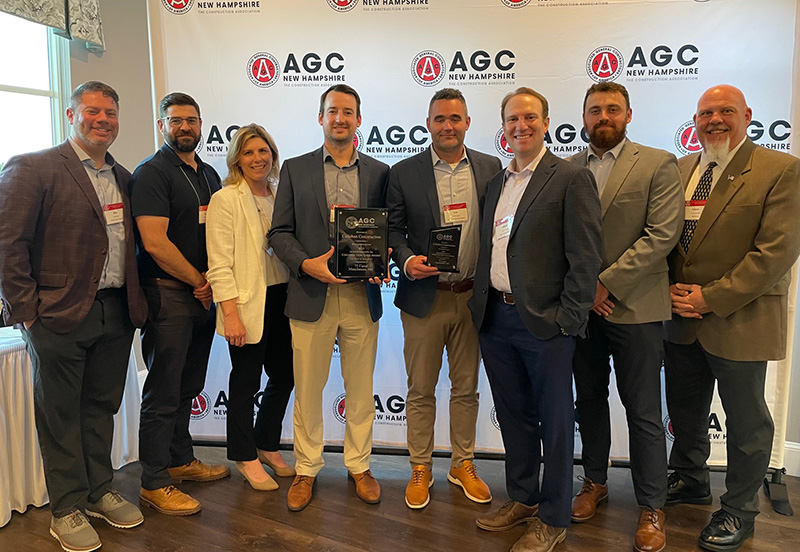News: Construction Design & Engineering
Posted: August 15, 2013
HMFH Architects receives 2013 CEFPI award
HMFH Architects has received a "Project of Distinction" award from the Council of Educational Facility Planners International (CEFPI) at the Northeast Regional conference for its design of three new elementary schools for the Concord School District. The recently completed Abbot-Downing Elementary School, Christa McAuliffe Elementary School, and Mill Brook Primary School all feature a Learning Corridor, a unique model for elementary education that provides a bridge between a traditional library and 21st century learning spaces that promote flexibility, collaboration, technology and social interaction.
The annual Northeast Region CEFPI Exhibition of School Planning & Architecture recognizes projects that stand out as exceptional and inspiring. The jury considers how well the project satisfies its own planning and design intent, as well as responses in the areas of learning environment, physical environment, community environment and planning process, and applicability to conference theme. The 2013 conference theme is educational renaissance.
"We are very proud that CEFPI has recognized HMFH for its work in creating three innovative schools for the Concord School District," said Laura Wernick, AIA, REFP, LEED AP, senior principal at HMFH Architects.
"Each of these schools was designed with direct input from the community, and the district's forward-looking vision for its schools challenged us to rethink the standards of elementary school facilities. The use of the Learning Corridor in the heart of the schools supports differentiated instruction with a variety of learning environments for the 21st century learner. We are honored to be recognized by a jury of our peers for this innovative design."
Initiated by the system's superintendent, Dr. Christine Rath, and based upon current understanding of brain-based research, planning for the new schools probed the very nature of K-12 learning. Input from the faculty, administration and local community played integral parts in the design process, which centered around three visionary ideas:
Spaces should support collaborative learning;
These collaborative spaces should be easily accessible by faculty and students to fully integrate them into the day-to-day learning experience; and
These spaces need to provide a variety of flexible environments to support a range of learning activities.
The resulting program features a two-story, 30-foot-wide Learning Corridor in place of a traditional library room with a variety of highly visible and easily accessible educational environments to encourage project-based learning and collaboration, and to support a range of learning styles and curriculum delivery methods. Although organized around the same Learning Corridor concept, each school is unique.
The Abbot-Downing Elementary School is located adjacent to the former Conant School site and echoes design elements from the original school building including the reuse of its signature cupola.
Named to honor the Concord teacher and astronaut who died 25 years ago in the Challenger shuttle disaster, the Christa McAuliffe Elementary School acknowledges its history by incorporating the ornate granite entryway from the former Kimball School, and continues a legacy of public school structures that have occupied that site since 1887.
The Mill Brook Primary School uses a colorful, childlike-block design to distinguish it from the adjacent Broken Ground Elementary School.
The Learning Corridor includes spaces for:
Group discussion
Wet/messy projects
Multimedia
Amphitheater
Story-telling
Book room similar to a traditional library space
Small project room
A "reading nook" for quiet, individual learning.
All three new schools were constructed with extensive recycled and locally-produced materials and are certified by the Northeast Collaborative for High Performance Schools (NE-CHPS) as green school buildings, meeting strict sustainability standards.
Harvey Construction Corp. served as the project contractor for all three projects.
MORE FROM Construction Design & Engineering
Nobis Group awards Robinson and Moreira STEM scholarships
Concord, NH Nobis Group, a 100% employee-owned consulting firm specializing in engineering and environmental solutions across the Northeast, has named the recipients of its 2025 STEM Scholarship: Andie Moreira of
Columns and Thought Leadership

Careers in Construction Month focus on training and safety - by Joe Camilo
October is Careers in Construction Month, and rarely has it been more consequential. According to our chapter’s national parent organization, the construction industry needs to attract half-a-million new workers in the coming year to meet demand. Addressing that need is a huge job, but we at ABC MA are trying to do our part.

The design-build advantage: Integrated interior design solutions - by Parker Snyder
When it comes to corporate interior spaces for both commercial and industrial projects, partnering with a design-build firm with in-house interior design services can offer clients many benefits. Unlike traditional delivery methods where interior designers operate independently from the design and construction teams, often creating a longer project timeline as cost negotiations and revisions ensue

Ask the Electrician: Is summer a prime time for commercial electrical maintenance?
The answer is “Yes!” While January marks the official new year, many businesses view September as a fresh start. This makes summer an ideal time for commercial property owners to schedule long-term electrical maintenance projects.

The rise of incubators and co-working spaces: The latest in life sciences - by Matt Combs
In recent years, the life science industry has witnessed a shift in how companies operate and innovate. One of the key driving forces behind this transformation is the emergence of incubators and co-working spaces specifically tailored to meet the unique budget and schedule needs of startups.








